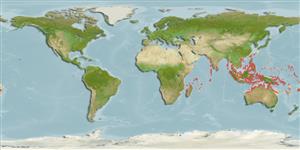Common names from other countries
>
Eupercaria/misc (Various families in series Eupercaria) >
Scaridae (Parrotfishes) > Scarinae
Etymology: Scarus: Greek, skaros = a fish described by anciente writers as a parrot fish; 1601 (Ref. 45335).
More on author: Valenciennes.
Environment: milieu / climate zone / depth range / distribution range
Ecologia
marinhas associadas(os) a recifes; intervalo de profundidade 2 - 18 m (Ref. 9710). Tropical; 30°N - 24°S
Indo-West Pacific: India to Vanuatu, north to the Ryukyu Islands, south to New Caledonia; Palau (Belau) in Micronesia.
Tamanho / Peso / Idade
Maturity: Lm ? range ? - ? cm
Max length : 40.0 cm TL macho/indeterminado; (Ref. 48636)
Descrição suscinta
Chaves de identificação | Morfologia | Morfometria
Espinhos dorsais (total) : 9; Raios dorsais (total) : 10; Espinhos anais: 3; Raios anais : 9. This species is distinguished by the following features: 6 median predorsal scales; 3 scale rows on cheek 1(5), 2(5-6), 3(2); lips largely covering the dental plates; caudal fin is truncate to slightly rounded. Colour overall is green to purplish or bluish, sometimes a pink patch on pectoral region, often with lime-green saddle on upper caudal-fin base, a dark green 'moustache' and pale green patch on cheek (Ref. 90102).
Inhabits coral-rich areas of outer channels and seaward reefs (Ref. 9710). Occurs singly or in small groups (Ref. 9710) over intertidal flats to graze on algae during high water mark (Ref. 48636).
Ciclo de vida ou comportamento de acasalamento
Maturities | Reprodução | Spawnings | Egg(s) | Fecundities | Larvas
Oviparous, distinct pairing during breeding (Ref. 205).
Myers, R.F., 1991. Micronesian reef fishes. Second Ed. Coral Graphics, Barrigada, Guam. 298 p. (Ref. 1602)
Status na Lista Vermelha da UICN (Ref. 130435)
CITES (Ref. 128078)
Not Evaluated
Ameaça para os humanos
Harmless
Uso pelos humanos
Pescarias: espécies comerciais
Ferramentas
Relatórios especiais
Baixar XML
Fontes da internet
Estimates based on models
Preferred temperature (Ref.
115969): 26 - 29.3, mean 28.6 (based on 2738 cells).
Índice de diversidade filogenética (Ref.
82804): PD
50 = 0.5000 [Uniqueness, from 0.5 = low to 2.0 = high].
Bayesian length-weight: a=0.01660 (0.00936 - 0.02944), b=3.12 (2.96 - 3.28), in cm Total Length, based on LWR estimates for this species & Genus-body shape (Ref.
93245).
Nível Trófico (Ref.
69278): 2.0 ±0.0 se; based on diet studies.
Resiliência (Ref.
120179): médio(a), tempo mínimo de duplicação da população 1,4 - 4,4 anos (Preliminary K or Fecundity.).
Fishing Vulnerability (Ref.
59153): Low to moderate vulnerability (30 of 100).
